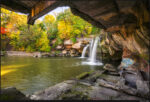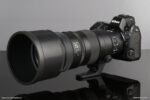Image Quality
Sharpness

The XF 50-140mm f/2.8 OIS is frankly an extremely impressive lens when it comes to optical quality, and that begins with image sharpness. The lens starts out very sharp over the central 75% of the frame, with still very good edges and corners right from f/2.8 throughout the entire focal range. Stopping down brings the center into outstanding territory and the edges to excellent. Surprisingly, the lens performs nearly as well at further focus distances as it does closer up.
While the corners at f/2.8 won’t match the very best primes available, frankly it’s not very far off. I have no hesitation whatsoever shooting at any aperture at any focal length with this lens, even when the subject is near the edges of the frame. Click on the image to the right to enlarge, then click on the green arrow at the bottom to view the image at full size.
Bokeh
The Fuji 50-140mm generally produces very pleasing out of focus renderings, but there are definitely situations where the worst of the lens comes out. In the majority of situations, the lens produces smoothly rendered blur with evenly illuminated specular highlight discs and lovely falloff. However, a very close examination of specular highlights shows a slight double dark edge around the outside. In most situations, this has no negative impact on the image. However, when shooting at wider focal lengths on further subjects with busy backgrounds, it can combine to produce very nervous bokeh. Given what I saw in most of my images, I’m very pleased with the lens’ performance in this area.
The only real negative regarding bokeh is that the specular highlights do take on a cat’s eye appearance due to mechanical vignetting. Any highlights that are outside of the center of the image will have this visible to varying degrees. I personally never mind this look, but if you don’t like it, you probably won’t enjoy that characteristic of this lens.

Color, Contrast and Chromatic Aberration
The XF 50-140mm produces images with excellent contrast and rich color at all image settings. The images aren’t overly contrasty but provide real depth to the files and lots of latitude in post. I really like the way the lens draws in this regard.
The biggest surprise to me with the lens was the total absence of any chromatic aberration. I don’t do test charts or measurements, so it’s possible there’s a small amount a testing instrument could pick up, but looking at the images (developed from RAW), I saw absolutely none. No lateral CA, and even more surprising, no longitudinal CA, even when shooting white text at an angle…just smooth tonal transition and pure black and white in those instances. Likewise, on high contrast subjects like chrome or backlit dark objects, I saw absolutely zero purple fringing. I’m truly stunned by the performance of the lens in this department.
Distortion, Flare and Vignetting
The 50-140mm also turns in outstanding results in these three categories. There’s really no field relevant distortion from the lens, and vignetting is very mild at f/2.8 and negligible by f/4. I was similarly impressed by the performance against bright light. Even with the sun in the frame at a slight angle, only minimal loss of contrast occurred and no major ghosting or flare artifacts were visible in the shots I took. The lens uses a new ‘Nano-G’ coating from Fuji that may be helping turn in this impressive performance.
Overall, if you couldn’t tell by now, the 50-140mm f/2.8 is an optically stellar lens. Only some imperfect bokeh (that I still generally like) and some very minor corner softening at f/2.8 keeps it from being essentially flawless. It’s easily the best zoom lens in the Fuji lineup, and by a rather wide margin. The lens really competes on the level of the excellent high-end primes in the XF lineup.





Leave a Reply